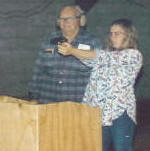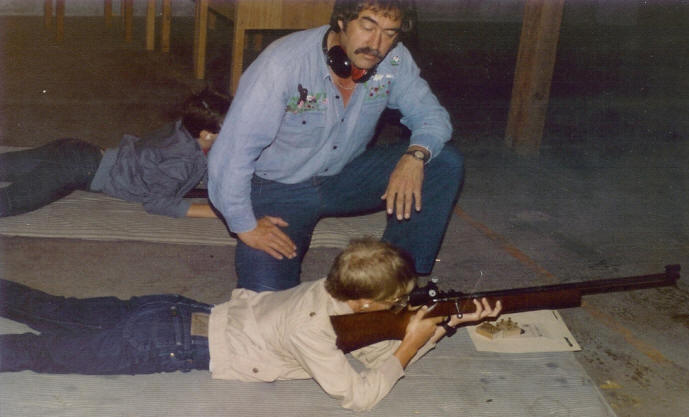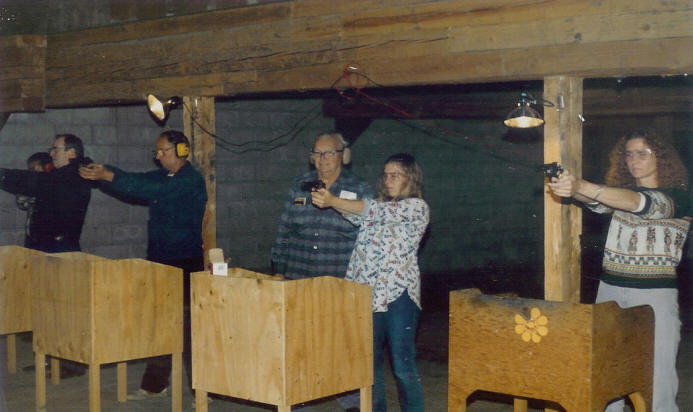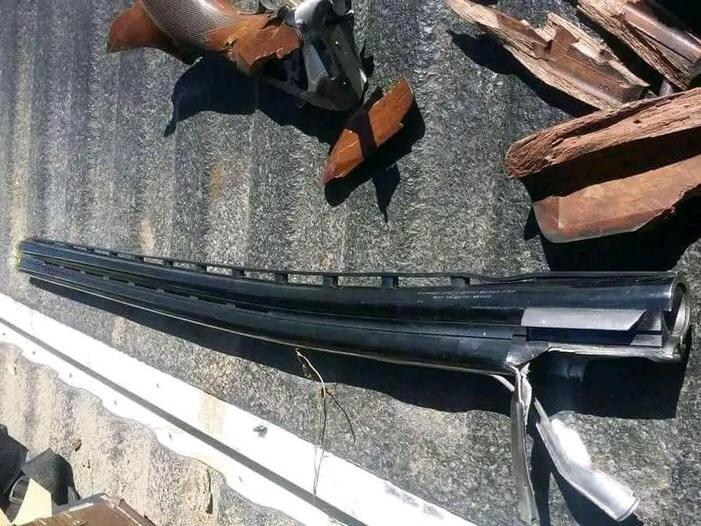
Firearm Range Safety Rules & Etiquette

 |
Firearm Range Safety Rules & Etiquette
|
 |
Safety ; For any firearm usage, safety is the prime consideration. This is if you are in the field alone or on a range where there are a number of other firearm enthusiasts, more-so with more bodies present. Here everybody has to be on the same page at all times. Each range will have a required set of posted Range Rules.
Established shooting ranges provide a safe and enjoyable place to practice with your firearms. They provide a safe backstop for the fired bullets. They also ensure that shooters shoot at safe targets and follow common sense safety rules. Most ranges are also located in convenient locations and can spare shooters a sometimes exhausting search for safe shooting property. However, shooting at your local range is a communal activity. While shooting is generally a very safe hobby, loaded firearms demand concentration and respect. Every range and every shooter at the range expects safety rules to be followed and conduct to fall within the bounds of generally accepted range etiquette. S A F E T Y starts by using good common sense. Think before you act! If you are not sure of what you are about to do, then don't do it or ask first! Ignorance here is no excuse. Range Rules are posted for EVERYONE'S safety, OBEY THEM, or be prepared to being asked to leave. Some ranges are operated as a business and have paid staff, while others are ran by a club and use volunteers as range safety officers. Others may issue a key to paid up members, which in that case, EVERYONE there has the responsibility of safety being the NUMBER ONE PRIORITY.
Here are some examples of basic range rules etiquette
that you may find:
Firearm Operation ;
Every
person who enters a firearm range is responsible for knowing how the weapon
operates before they are to fire it at the range. If you are not
sure how everything works on the weapon you are about to use, then don't use it
in presence of others.
You are liable if you injure someone, or damage property. Read the
instructions that came with the firearm. If you don't have a copy,
then write the manufacturer for one. Ask the person who sold you the
firearm to explain all the operational features of it, if they can't, then find
someone who can before you attempt to fire it.
Safety and Security of Firearms ;
You are responsible for the safety and security of your firearms!
All gun safety rules WILL be followed. Read the rules and practice them.
Many ranges have a sand trap at the entrance door, that is used when clearing a
firearm (usually a semi-auto pistol). It is not intended to be shot into,
but as a safety device in case of a Accidental Discharge during the time when
there is a greater possibility of it happening.
NO
LOADED FIREARM SHALL ENTER A RANGE.
(1) The muzzle of your firearm should always be pointed in a safe direction. Your fingers should be off the trigger until you are on the firing range and your firearm is pointed at your target. You should not be handling your firearm until the range officer issues the load command, before that the firearm should be on the bench, bolt open or slide locked back and not loaded, with you the shooter standing rearward of the bench. Nothing angers a shooter more than having someone carelessly point a gun at them for even a moment. Muzzles should always point down range. When you are packing up to leave and you've unloaded your weapon, the muzzle should be controlled and pointed in safe direction (usually away from anyone and down toward the floor).
(2) Eye and Ear Protection will be worn by all who are firing a weapon OR observing one firing on it.
(3) Making the Firing Line Safe. Before going forward
of the firing line, guns are made safe by having the SLIDES BACK,
MAGAZINES OUT, CHAMBERS EMPTY, CYLINDERS OPEN, BOLTS BACK and
the EJECTION PORT VISIBLE FOR INSPECTION. Then place the gun on the bench
with the muzzle pointing down range. Step rearward 2 steps so the range officer
can visually inspect all on the line.
(4) Loading and Unloading Firearms. All weapons shall
be loaded and unloaded ONLY on the indoor and/or outdoor FIRING LINE. There
are THE ONLY EXCEPTION TO THIS RULE WOULD BE AT THE SAND TRAP AT THE DOOR !
(5) All range commands should be followed immediately. If the range
officer (or anyone else) yells, "CEASE FIRE!" That means you immediately
stop shooting and generally open your firearm's action (to remove any chambered
bullet), lay your firearm down on the shooting bench, and to be polite step away
(back) from it.
(6) Do not touch or handle ANY firearm during a ceasefire. This includes
picking up your firearm to pack up and leave. If you have walked down
range during a ceasefire to change or examine your target, there is nothing more
unnerving than looking up range to see someone handling their firearm.
(7) If you have a miss-fire during a match, hold the
firearm with the muzzle pointing up, wait for the course to run it's time and
wait for the range officer to come and clear your firearm. OK, you can do
it yourself, but the others on the line may not know your qualifications, so let
a person in command do it. This may also qualify you to shoot an alibi
string if shooting in a match.
(8) Don't start shooting again until the range officer has yelled, "Commence
Firing!" or sometimes "The Range is hot!" And, only fire, if you've verified that
the range is safe with your own two eyes.
(9) Don't go forward of the firing range until a cease fire has been called.
That's just crazy.
(10) No horseplay. Bullets don't play and neither should you.
(11) Don't interfere with other shooters. Don't tap them on the shoulder
as they are about to shoot. Don't interrupt anyone unless you see they are
in some immediate danger.
(12) Don't shoot inappropriate firearms. Don't shoot black-powder firearms
indoors. Don't disobey caliber or ammunition limitations. If your
range doesn't allow shooters to fire tracers, armor piercing bullets, or .460
Weatherby Magnum elephant guns, they have a good reason. They don't want
to create a fire hazard or damage their expensive backstop/bullet trap.
(13) No bloviating. Don't be a bore offering your unsolicited critique of
other shooter's firearm choice or technique. If you can't say something
nice and you aren't commenting on a safety concern, hold your tongue.
(14) Clean up when you are finished. Don't leave a trashy shooting
station for the next shooter. Throw away any ammunition packages, old
targets, and other trash that you have generated during your shooting session.
Even pick up after the previous shooter if need be. At most ranges, you
are expected to grab a broom and dustpan and quickly sweep up the used shell
casings (commonly called "policing the brass") around your area.
Some ranges provide a recycling bucket for the shell casings. Other
ranges just want you to sweep the brass forward of the firing line so that it
won't pose a slip and fall hazard to other shooters. Range personnel
can collect
the brass at the end of the day.
GENERAL RANGE COMMANDS
Purpose
The purpose of range commands is to provide concise, clear and standard
methods of range operation. This provides the shooters or participants
with easy to understand guidelines and enhances safety.
All sanctioned competitions and many organizations have standardized
range commands that may supersede the commands contained herein. The
designated range officer may also modify the specific command language if all
command steps are otherwise followed.
Basic Range Commands
The following commands are provided along with their purpose and a
description of the action that should result. All commands are given by a
designated range or safety official, except for cease-fire '-- or misfire.
A cease-fire may be called by anyone detecting an unsafe situation. In the
event of a misfire, the shooter having trouble should alert the range officer
immediately. If a range officer is not formally assigned, then
participants should mutually designate a person to perform the function.
Commands and Actions to
indicate EMERGENCY or HAZARDOUS CONDITIONS
Command : CEASE FIRE!
Purpose: Stop all shooting routinely or, in case of emergency,
immediately.
Action: Participants immediately stop shooting, continue to keep the
muzzle pointed down range, remove finger from within the trigger guard, unload
and clear the firearm and await further instructions from the range officer.
Command :
MISFIRE!
Purpose: Notify the range officer and other participants that a round did not
fire when the trigger was pulled and to alert other shooters along the line that
a hazardous condition may exist.
Action: The shooter experiencing the misfire continues to keep the firearm
pointed down range, removes the finger from within the trigger guard and awaits
further instructions. The range officer may or may not call a general
cease-fire depending upon the situation. Shooters immediately
adjacent to the misfire should cease fire, unload, open and either ground or
bench their firearms and step back from the line. The remaining
shooters may continue to fire as directed by a range officer or may cease fire
at their option and await further instructions.
Preparing the range for live firing
Command :
"LOAD!" (optional for
training)
Purpose: Notify participants that they can load the prescribed number of
rounds.
Action: Participants will load the prescribed number of rounds and stand
ready for the next command. The firearm may be on the shooting bench, mat,
or hand held at the shooter's discretion, pointing downrange.
Command :
"IS THE LINE READY?"
Purpose: Determine if all shooters along the line are ready.
Action: All shooters not ready should indicate their status to the range
officer. Sufficient time will be allowed for the shooter to complete his
preparation.
Command :
"READY ON THE RIGHT!"
Purpose: Declare that the shooters have indicated they are ready.
Action: Any shooter not ready at this command may chose to either alert
the line officer that he is not ready or to complete the process of getting
ready before the final command has been given.
Command :
"READY ON THE LEFT!"
Purpose: Continues the command prior to giving the commence firing command.
Action: Any shooter not ready at this command may chose to either alert the line
officer that he is not ready or to complete the process of getting ready before
the final command has been given.
Command :
"READY ON THE FIRING LINE!"
Purpose: Notify all participants that the range is about to be under live
fire and that if anyone is not ready at this point, he should call a range
officer; otherwise, await the next command.
Action: Participants simply await the next command.
Command :
"COMMENCE FIRING!" or "FIRE"
Purpose: Declare the range formally open for live fire.
Action: The participants may commence the prescribed course of fire.
Firing Period
Firing shall continue until a predetermined time period has lapsed or until all
participants have completed the prescribed course of fire. During informal
shooting events, participants when finished firing should simply open the
action, clear the firearm, bench or ground the firearm and step back behind the
line and wait until all shooters have completed the event. After this, a
mutually agreed upon cease-fire is called.
To stop firing and declare the range safe
Command :
"SHOOTERS YOU HAVE (X) NUMBER OF MINUTES LEFT TO COMPLETE THE COURSE OF
FIRE or SHOOTERS FIRE YOUR REMAINING ROUNDS."
Purpose: Alert all shooters that a general cease-fire is about to be
called and to allow the slower shooters to complete the course of fire.
Action: Those that have completed the day’s activities may put away their
equipment. In the event there are rounds remaining that have not been
fired, the shooter, upon the command "Cease Fire" simply unloads, clears and
grounds or benches his firearm.
Command :
"CEASE FIRE!"
Purpose: Stop ALL firing.
Action: All participants shall unload, open, remove magazines and bench or
ground all firearms. If activities are complete for the day, step back
from the line or clear the area by packing away firearms, ammunition, other gear
and cleaning up the area.
Command :
"THE RANGE IS CLEAR!"
Purpose: Alert all shooters along the line that travel beyond the firing
line for purposes of target change or retrieval, the removal of brass and trash
is approved.
Action: Participants may move down range as directed or desired to change,
remove targets or to clean up. The next relay shall not take up positions on the
firing line until told to do so. Participants not going down range are to stand
back from the firing line and away from firearms. NO firearm will be handled
while others are down range.
Finally, when everyone obeys the basic rules of range etiquette and common decency, shooting at the local community range is a lot more fun.
| Here a range officer is giving rifle instruction to a Boy Scout |
 |
| Here a range officer is giving one on one instruction on the pistol line |
 |
Observations ; If an issue concerning firearm safety pops up, it will usually be to those who are uninformed, not familiar with their firearm, or temporarily confused. If you see ANYTHING that you consider not safe gun handling, tell the range officer or if they are not immediately available, inform the offending person yourself. This person may need to have a refresher course in firearm handling. Initially approach them in a nice way. The whole issue is firearm safety. If they do not understand what they just did, point it out to them and the reason behind it not being a good idea. Offer to brief them on range safety rules. If they get upset, so be it. If a accident happens, they are the one that is liable and you may be the the victim.
I remember a number of years ago when I was involved in women's firearm safety classes. We spent hours covering all the aspects of owning/using a firearm, which included allowing them to observe and handle all types of unloaded firearms to acquaint them with what may be the best type for them. After all the initial book learning and instructions along with dry firing, loading, unloading, we took them to the range for actual live firing. If they already had a personal firearm, we allowed it to be used for the final actual firing. Here we had a instructor personally coaching each shooter (one on one) at the firing lines.
The one time I remember vividly was my student being a small middle aged lady who brought her personal Titan 25ACP automatic pistol. It soon became obvious that she had no clue as to the function of this firearm. I got it loaded, handed it to her and she proceeded to shoot the 1 round I had placed in the gun. OK maybe she is starting to understand. We loaded the magazine with 2 this time, which went OK. Then I loaded 4 and she proceeded to fire more. At this point I can not remember what happened except that she stopped shooting, with the gun loaded, her finger on the trigger and with the gun's hammer back in the cocked position, she turned to me with the barrel within inches of my belt buckle. I can tell you that chills go up and down your spine in a situation like this. If I am going to be shot, I would prefer it was for some reason that I had done wrong, instead of by accident. To this day, she has not a clue what she (a distant cousin of mine) did that day.
I have seen a number of accidental discharges during my lifetime, with most being from an "empty" gun. Someone did not totally empty the firearm when they put it away, or there was a malfunction and it did not eject a live round, or a number of other reasons. Other situations were during a loading/unloading process.
The one thing I want to stress is that when you are handed a firearm, ALWAYS check it YOURSELF for being unloaded. If you are unfamiliar with that type, do not be ashamed, ask someone to clear it for you. This pertains to ANY TIME you pick up a firearm, even if it has been handled by 10 others just prior to you picking it up. YOU need to be sure yourself. Some firearms are simple to check (revolvers) but semiautomatics need to be cycled to checked.
A Less Occupied Range ; OK, some of us may frequent a not so busy or a private range. Some ranges could be only in a farmers back field or woodlot, taking into account of a safe backstop area of course.
Range safety is still an prime issue. If there are only a couple other shooters practicing or sighting their firearms or getting ready for hunting season, you still need to work/shoot somewhat in unison or at least in cooperation with them, by notifying them when you are about to shoot and they need ear protection. You also need to mutually agree to a cease fire to go forward and examine or change targets. You may need to wait a while until they have fired what rounds they wanted. Usually if they are going to be there for some time, they will stop and ask if you need to hang or change targets.
The firearms should always have the actions open when not actually on the firing line. And if loaded, to be pointing downrange or in a prescribed gun rack.
Ear protection is a necessity, if you don't think so, ask anyone who has worked in a noisy environment. Hearing aids are just that, AN AID and not anywhere near what the original style that mother nature provided.
Finally remember to pick up any garbage you may have dropped, even that what others have left.
Public Lands Impromptu Range ; OK, you have found isolated location at the end of a county road or in a un-gated logging area that could be suitable for your anticipated needs. Again, safety is the prime consideration. In situations like this, especially on public lands, you never know when someone may drive up. or a hiker popping out of the wooded area around you. Some county ordinances even do not allow discharge of firearms in a abandoned gravel pit. This is because of possible ricochets of bullets where the terminal destination that you are responsible for may be a considerable distance away (even back at you).
Remember that you own the bullet you have sent downrange, until it is an intonate object, has no movement, and laying on the ground or buried in a dirt bank.
And again, pick up your brass, used targets, and soda cans (YOU WILL NOTICE I DID NOT MENTION BEER CANS). Do not use glass bottles as a target. Again pick up any garbage you may have dropped no matter how small, even that what others have left.
| Not what we want to see | Nor this |
 |
 |
Personal Safety ; This is not range related, BUT probably worthy of the general public understanding. In the photo below, you see total destruction of a fine Over/Under 12 ga shotgun. The situation here was that somehow a 20 ga cartridge was dropped into the bottom chamber, unknown to the shooter. Then a regular 12 ga was inserted in, the action closed and the trigger was pulled. BOOOOM. Here the 20 ga was just small enough to go completely inside and allow the gun to close normally on it's 12 ga cartridge. This is like a mini bomb when the 12 is fired right on top of the 20.
This has been a safety issue for some time,
so the ammo manufactures have unilaterally decided to make each smaller gauge
a different identifying color as a safety concern. They left the 12 ga color
alone because it is not subject to this issue, being larger and that the major
companies were firmly committee to their colors, red for Winchester, green for
Remington and dark purple for Federal. They set 20ga as yellow and 16ga
as light purple.
|
Here you can see the destruction, it is
unknown as to the injury to the shooter whereas the whole forearm disintegrated in their hand, along with the trigger finger being closer |
 |
Copyright © 2013 - 2025 LeeRoy Wisner All Rights Reserved
Back to the Main Ramblings
Page
Originated 01-16-2013, Last updated
01-31-2025
Contact the author